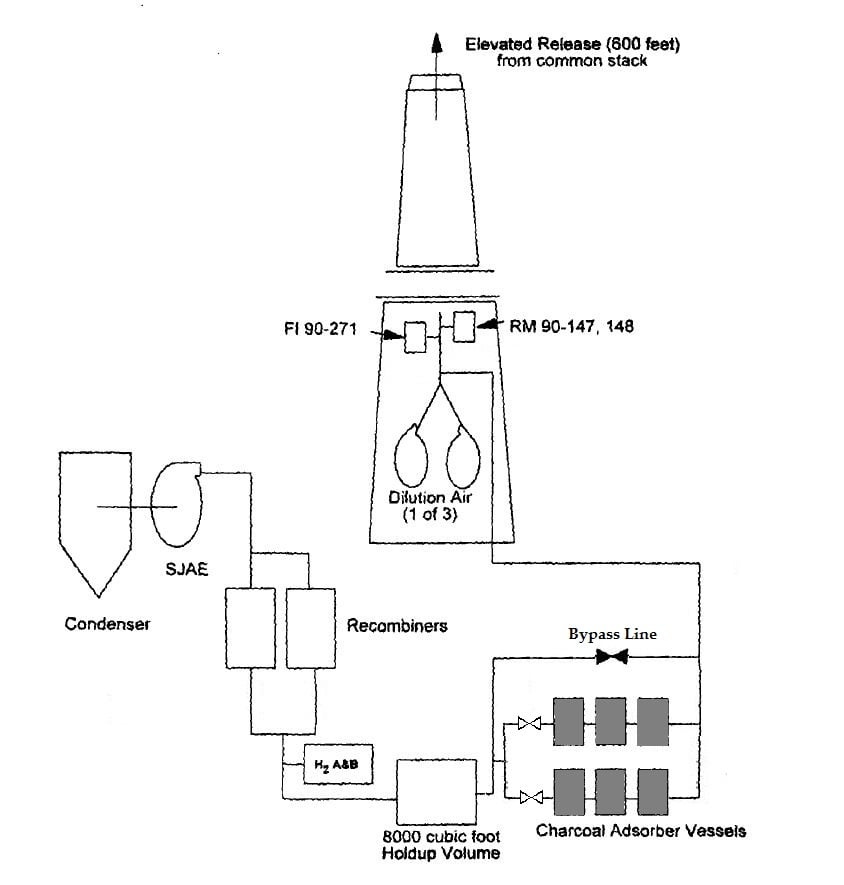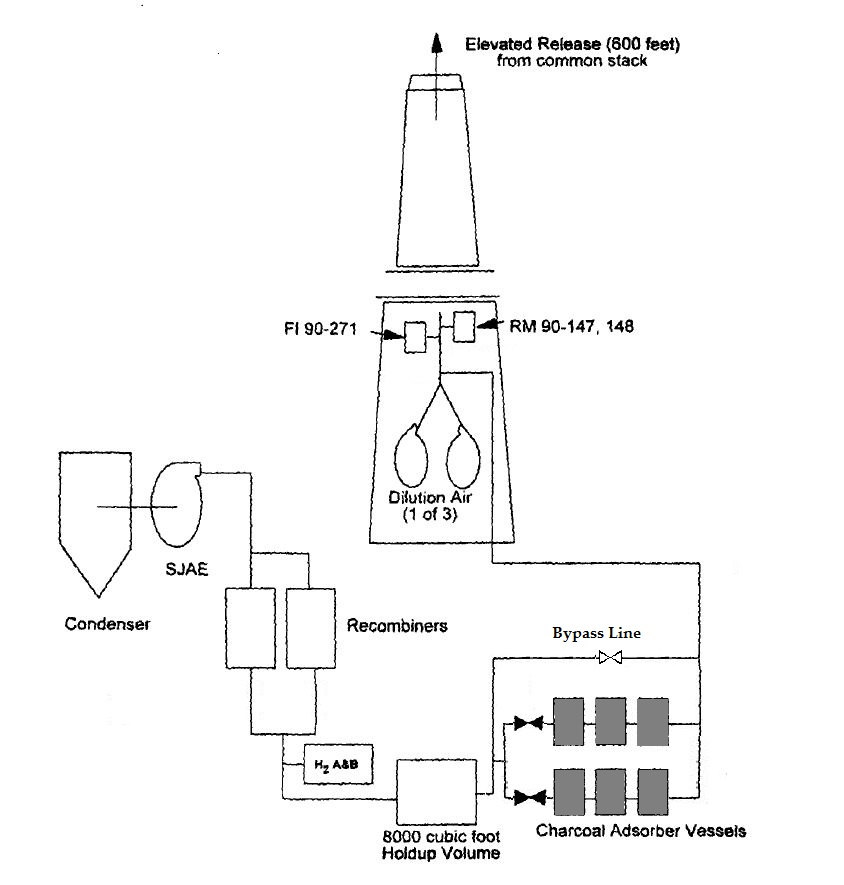Fission Stories #195
Workers restarted the Unit 1 boiling water reactor (BWR) at the Browns Ferry Nuclear Plant near Athens, Alabama in early November 2014 following a routine refueling outage.
How things are supposed to work
In BWRs, water flowing through the reactor core gets heated to the boiling point. The steam flows directly to the turbine/generator. Steam exits the turbine into the condenser. River water flowing through thousands of metal tubes inside the condenser cools the steam to turn it back into water. The water is pumped back to the reactor vessel to be re-used to make steam.
The Steam Jet Air Ejector (SJAE) pulls air, non-condensibles (e.g., radioactive nitrogen and iodine gases), and some steam from the condenser (See Fig. 1). The buildup of air and non-condensibles inside the condenser impairs its ability to convert steam back into water, so the SJAE functions to optimize the condenser’s performance.

Fig. 1. (Source: Tennessee Valley Authority, Figure 7.1 annotated by UCS)
The flow pulled from the condenser passes through recombiners. As water flows through the reactor core, interactions with atomic particles whizzing about causes some of the water molecules to break apart into hydrogen and oxygen molecules. The recombiners function to put hydrogen and oxygen molecules back together. The water formed by these recombinations flows back to the condenser through a pipe not shown in the diagram.
The remaining flow passes by instruments (H2 A&B) that measure hydrogen concentration. As the Hindenburg conflagration and the Fukushima explosions reminded us, hydrogen gas buildup can be hazardous.
The flow then enters the 8,000 cubic foot holdup volume. This component is essentially just a much larger pipe. The flow slows down as it enters the larger pipe section, thus taking longer to reach the next step in the flow path. This slowdown, or holdup, provides time for the decay of radioactive elements with shorter half-lives.
Normally, the flow then enters the charcoal adsorber vessels. Each Browns Ferry unit has six large metal tanks filled with tons of charcoal. Radioactive particles in the flow get adsorbed by the charcoal, delaying their release until swept away by the flow or knocked off by another particle. The delay imposed by adsorptions further delays release and allows more radioactive isotopes to decay.
In addition, there are high-efficiency particulate absorption (HEPA) filters before and after the charcoal adsorber vessels that actually remove particles from the flow.
The flow gets discharged from the plant through a 500-foot tall chimney.
Collectively, these components significantly reduce the amount of radioactivity released from the stack. The radioactivity level measured by the Radiation Monitors (RM-90-147 and RM-90-148) is less than one percent of the level pulled from the condenser by the SJAE.
Rising temperatures at Browns Ferry
Shortly after restarting the Unit 1 reactor in early November, workers observed the temperature increasing within one of the six charcoal adsorber vessels.
Workers responded to the rising temperature by isolating the charcoal adsorber vessels on November 8 and supplying them with nitrogen gas. Nitrogen purging is the common method of reducing temperatures by reducing the amount of oxygen and moisture available to the charcoal. The reactor was able to continue operating because workers opened the valve in the bypass line to allow the flow from the holdup volume to bypass the charcoal adsorber volume and proceed directly to the exhaust stack (Fig. 2).

Fig. 2. (Source: Tennessee Valley Authority, Figure 7.1 annotated by UCS)
Bypassing the charcoal adsorber vaults during reactor operation is permissible because the radiation monitors in the exhaust stack will cause the releases to be stopped if the radiation levels rise too high.
On November 14, workers restored the system to its normal configuration by terminating the nitrogen purge and re-admitting flow through the charcoal adsorber vaults.
When temperatures began rising again in that same one of six vaults, workers once again bypassed the charcoal adsorber vaults and instituted nitrogen purging.
After several days of nitrogen purging, workers restored the system again to its normal configuration on November 22, 2014.
When temperatures inside the single vault began rising for the third time on November 25, workers bypassed the charcoal adsorbers again.
Because the charcoal adsorber vaults were bypassed for longer than seven days, the plant’s owner reported the problem to the NRC.
Workers believe that a buildup of hydrogen in the pipe downstream of the recombiners led to an ignition that started a fire in one of the six charcoal adsorber vaults. Workers suspect that a plugged valve allowed too much steam to flow from the SJAEs to the recombiners. This excessive steam flow was too much for the recombiners to handle, allowing the hydrogen concentration in the downstream pipe to rise to the combustible level.
The NRC was informed of plans to replace the faulty valve during the refueling outage scheduled for November 2016.
Our Takeaway
BWRs have a long history of hydrogen detonations, even before Fukushima. Millstone Unit 1 in Connecticut experienced a hydrogen explosion in December 1977 that blew the stack building’s door into a warehouse nearly 200 feet away. The Cooper Nuclear Station in Nebraska suffered a hydrogen explosion in September 1999 that damaged the ventilation system intended to filter radioactive releases following an accident.
In the intervening decade, charcoal at the Perry nuclear plant in Ohio was also ignited. But a hydrogen detonation did not start this June 19, 1986 fire. At the time, the plant was conducting many tests following its lengthy construction phase—operators had achieved the initial criticality of the reactor core on June 6. One of the tests involved checking the thermocouples installed inside the charcoal adsorber vaults and the associated alarms. Because the test was taking too long, workers moved space heaters closer to the vaults to provide external heat. It worked—the external heat started the charcoal on fire. The thermocouples dutifully recorded the soaring temperature inside the vault. The smoke helped to confirm the thermocouple readings.
The hydrogen explosions that demolished three reactor buildings at the Fukushima nuclear plant in Japan in March 2011 had more sinister consequences .
The pessimistic perspective on this latest hydrogen control problem would point out that despite reminders every decade or so, the nuclear industry has not been able to eliminate hazardous hydrogen concentrations from occurring.
The optimistic perspective would point out the demonstrated value of defense-in-depth. Browns Ferry has recombiners intended to reduce hydrogen concentrations in downstream piping below combustible levels. Browns Ferry also has thermocouples and nitrogen purge capability just in case.
Seeking to reduce the frequency of bad days is good. Having reliable safety nets in place when bad days occur is better. Not having to use the safety nets is best.
Needing safety nets but not having them is worst.
By this scale then, the NRC’s decision not to require filters in BWR containment vent pathways invites the worst. I hope luck prevents the NRC’s invitation from being accepted.
“Fission Stories” is a weekly feature by Dave Lochbaum. For more information on nuclear power safety, see the nuclear safety section of UCS’s website and our interactive map, the Nuclear Power Information Tracker.
